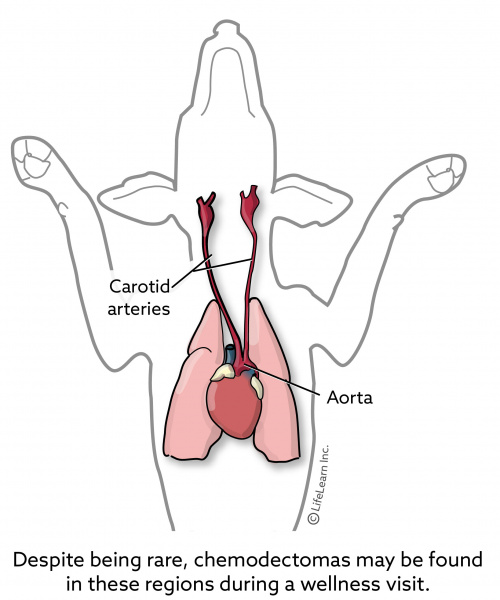Chemodectomas (Aortic and Carotid Artery Neuroendocrine Tumors)
What is a chemodectoma?
A chemodectoma is a type of tumor made up of chemoreceptor cells. Chemoreceptor cells detect chemical changes (such as oxygen content and pH levels) in the body and respond by regulating chemical or physical processes. A chemodectoma involves abnormal growth of these chemoreceptor cells in an uncontrolled way that causes the formation of a tumor.
The most common regions these tumors are seen are along one of the carotid arteries and the aorta. Two carotid arteries sit within your pet’s neck; one on each side of the trachea. The aorta is the large blood vessel that leaves the heart to deliver oxygenated blood to the body. These tumors are rare and may be found when your pet has a wellness examination or if your pet is exhibiting signs associated with these tumors.
What causes this type of tumor?
The reason why a particular pet may develop this, or any tumor or cancer, is not straightforward. Very few tumors and cancers have a single known cause. Most seem to be caused by a complex mix of risk factors, some environmental and some genetic or hereditary.
In the case of chemodectomas, short-nosed breeds (brachycephalic breeds), are more predisposed to these types of tumors (e.g., Boston Terriers and English Bulldogs). Because these breeds have chronic low oxygen levels due to the structure of their face, jaw, and airway, it is thought that the chemoreceptors are overworked, and tumor development occurs. German Shepherds and Boxer Dogs, as well as male dogs tend to be more predisposed to aortic body tumors.
What are the signs of chemodectomas?
Clinical signs of chemodectomas depend on the location of the tumor. The most common clinical signs associated with aortic tumors (located on the aortic artery) and the resulting pericardial effusion (fluid within the sac around the heart) include weakness/wobbliness, lethargy, collapse, exercise intolerance, increased respiratory rate and effort, cough, vomiting, and sudden death.
The most common signs associated with a carotid artery tumor (located in the neck) are swelling in the neck region, regurgitation, lethargy, difficulty breathing, weakness, and collapse.
How is this cancer diagnosed?
Your veterinarian may notice changes in your pet during a wellness examination such as increased breathing rate and effort, and swelling in the neck region. Your veterinarian may recommend radiographs (X-rays) or ultrasound of the chest, which may show evidence of a tumor in front of or around the heart, or fluid within the sac around the heart (called pericardial effusion). More commonly though, ultrasound or a CT scan of the chest and neck will show evidence of tumors.
"Your veterinarian may notice changes in your pet during a wellness examination such as increased breathing rate and effort, and swelling in the neck region."
Once a diagnosis of a mass on the carotid artery or aorta is made, your veterinarian may discuss performing an ultrasound-guided fine needle aspiration. Other techniques involving specialized equipment to obtain samples of carotid tumors and may be discussed. These techniques use an ultrasound probe to guide a small needle into the tumor to retrieve cells. The cells are placed on a microscope slide which is examined by a veterinary pathologist.
If the mass is close to the heart, these diagnostic techniques have significant risk of complications including bleeding. Because of these risks, once a mass has been diagnosed, surgical removal of the tumor may be recommended. Samples of the tumor will be examined under the microscope by a pathologist who will confirm the tumor type.
How does this tumor typically progress?
Carotid and aortic body tumors are commonly locally aggressive. This means that they penetrate the local tissues directly surrounding the area where they form. However, there are rare cases of metastasis (spread) to other organs including the lungs, lymph nodes, and bone.
What are the treatments for this type of tumor?
The most commonly pursued treatment is surgical removal of the tumor, regardless of location.
Your veterinarian may discuss with you the options for a pericardectomy. This involves removing the tumor as well as a part of sac that surrounds the heart (the pericardium). Pets that have a pericardectomy have improved recovery and live significantly longer.






